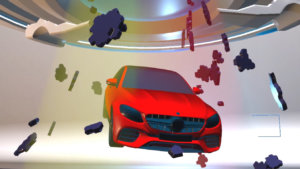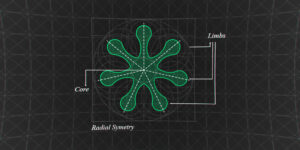After kickstarting the whole design process for the creatures of the ecosystem, I have been engaged on a back and forth process of iterating through the weak aspects of the designs and upgrading them.
Starting with the mechanical hunters, after showing the design around and evaluating them myself, I decided to do another pass on their parts and form, particularly on the legs (especially since some people ended up seeing a pencil compass, and we wouldn’t want that, would we?).
For a more grounded and plausible look I added a piston-like mechanism in the legs that connects from one section to another. Additionally (to get rid of the compass-like look) I redesigned the whole tip joint, basing the new design off of the look of prosthetic running blades. This gave the hunter a sleeker and overall more believable look.
A comparison of the designs that depict the evolution of the hunter development
Additionally, I included eye like elements on the front, as well as adjusted the proportions of the limbs and changed the overall design of its articulations.
A motion test to evaluate the rigging system
I might go back and revise the design once more in order to polish and improve other minor elements, but it was time to move on to the prey creature design that has been neglected for a while.
In the case of prey, they are organic in nature, but should feel alien-like. During my explorations last weekend I realized that even though I want to make the viewer have a visceral reaction to the creatures, I don’t want them to be based on gore, but rather a phobia-like sensation that insects or sea creatures produce. This had me reevaluate the approach a bit, and gather more images of water based organism. It’s worth mentioning that I have been using the work of Erik Fergusson, Richard Lord and Denis Kozlov and Elena Kozlova as reference and inspiration.
These non-mechanical creatures have proven to be very difficult to model procedurally. The process is very different from the one that produces the hunters, so in the end it has been more time-consuming than expected. It has certainly been a case of trial and error.
One of the failed results of the weekend
As you can see, at some point I attempted to incorporate shell-like tips on limbs with a blobby base that has a bit of the bulb-like tips of the crown jellyfish, but it was not a particularly successful result. Its design feels forced and not very natural.
That made me go back to exploring a different sort of limb, settling on a more traditional tentacle-like shape with a bifurcation at its tip, as well as a more aggressive distribution of its top appendages.
A sample generated by the current method
This new approach will also permit to modify aspects of the physiology of the creature like number of limbs, size, appendage distribution, among others.
A comparison of the design evolution of the prey type creature
Once the design was procedurally stable I made a simple rig for it using the same approach as with the hunter, KineFX drives the motion of the creature. And with a bit of code I randomly animated the creature’s limbs to posteriorly feed the deformed mesh as a rest shape for a Vellum simulation.
Motion test to evaluate the creature
Some more adjustments are coming up and hopefully will be published on the next blog post. After I lock the creature desings, the next steps will be to make them into proper HDAs of some kind with parametric controllers for the creatures and outputs that can be distributed across a soon-to-be-developed procedural environment. A bit intimidating! Words of encouragement are appreciated.
Anyway, thank you for reading and until next publication!








